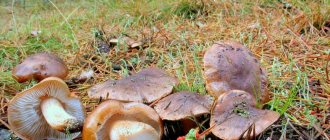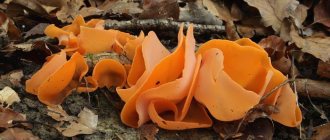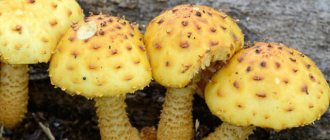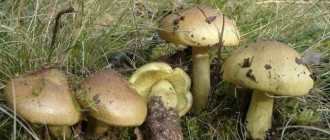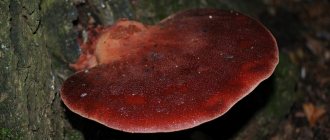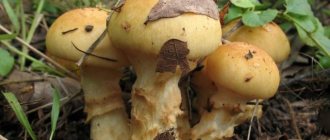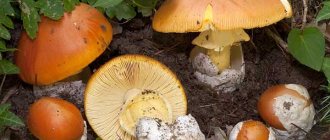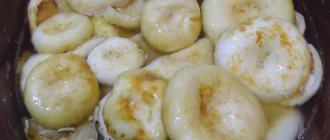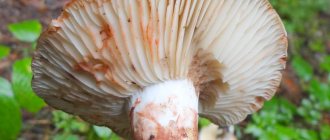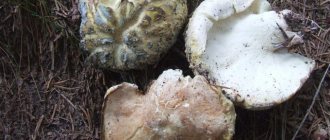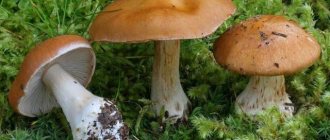What does a smooth mushroom look like?
According to the photo and description, smoothie is a large mushroom with a classic fruiting body shape. The diameter of its upper part can reach 7-15 cm. In young specimens, the cap is hemispherical, and its edges are turned down. It is convex in the center. As it matures, the upper part of the mushroom opens and takes on a funnel-shaped shape. With slight physical impact it easily breaks and crumbles.
The color of the cap includes bluish, lead and lilac shades. Young mushrooms most often have a light lilac cap, and then it becomes pink-brown or yellowish-lilac. The surface is smooth, but with high air humidity it becomes slippery.
The pulp is fleshy, dense, yellowish in color; when it is broken, a milky juice appears, which is white in the smoothie, but turns a little green when exposed to air.
The mushroom smell of the smoothie is practically undetectable
On the reverse side of the cap there are frequent descending plates of a light cream color. In ripe smoothies, yellowish stains or stains from leaking milky juice may appear on them. The spores are round, spiny, colorless. Their size is 8-11 x 7-9 microns. Creamy spore powder.
The leg of the smoothie is cylindrical, its length can reach from 5 to 15 cm, depending on the growing conditions. The thickness varies from 1 to 3 cm. The color is identical to the cap, but a shade lighter. At a young age, the mushroom forms a small cavity inside the stem, which only increases as it grows.
Important! Gladysh is not affected by worms, so its flesh always remains clean, regardless of age.
Similar varieties
Smoothies in nature have species similar in description, including:
- The milky mushroom is meat-red: it differs from the original one in the dark orange or brown color of the mushroom cap, contrasting specks on the stem and a very pronounced specific smell.
- Serushka: differs from smooth mushroom in the smaller amount of mucus contained on the mushroom cap, the cottony structure of the stalk and the less frequently planted hymenophore plates. Mushroom pickers often call these mushrooms subsoil mushrooms, bitter mushrooms, gray and purple milk mushrooms.
Is smooth mushroom edible or not?
According to official data, the common milkweed is classified as an edible species. But due to its peculiarity of secreting milky juice, it requires preliminary preparation before cooking. In terms of taste, it belongs to the second category.
Gladysh mushroom is considered the best for pickling, since during the cooking process it loses its bitterness and acquires a pleasant elasticity.
Important! The common milkweed should not be consumed raw, since its juice, which it secretes, disrupts the functioning of the digestive organs. This is manifested by vomiting, abdominal pain and a feeling of heaviness.
Strange habits of the “water bee”
The common smoothie has a German nickname - Wasserbiene, which means “water bee”. The fact is that a waterbug bite feels close to a bee sting. Therefore, the Germans came up with a very apt name for smoothie.
The common smoothie is not a very aggressive bug and does not attack people
But when they, neglecting basic caution, try to pick up an insect, the smoothie will immediately respond with a burning injection, the consequences of which will be felt for a long time. It is mainly the most curious and careless children who suffer from the bites of common smoothies.
Attention, TODAY only!
Similar
False doubles of Gladysh vulgare
As can be seen in the photo, it is difficult to confuse the common milkweed with other species due to the peculiar color of the fruiting body. But not all novice mushroom pickers are able to accurately distinguish smooth mushrooms from their doubles. Therefore, similar species and their characteristics should be studied.
Faded milkman
This is a close relative of the common smoothie and also belongs to the Russula family. The upper part is gray-brown or wine-brown. Moreover, its center is much darker. The leg is slightly lighter, tapering at the base. The size of the fruiting body is smaller than that of the smooth one. The diameter of the cap is 4-10 cm, and the length of the stem is 4-8 cm. When the pulp is broken, milky juice oozes abundantly. It is white in color, but acquires an olive tint when exposed to air. The mushroom is considered conditionally edible and requires pre-soaking. The official name is Lactarius vietus.
The taste of the pale milky pulp is hot-sharp
Serushka
This species also belongs to the Russula family and is considered conditionally edible. You can often hear other names for the fungus: gray hollow, seryanka, putik, podoreshnitsa, plantain. The diameter of the upper part reaches from 5 to 10 cm. Its shape is initially convex and then becomes funnel-shaped, but a small elevation remains in the center. The edges are uneven and wavy. The surface has a grayish-lead tint, the mucus is an order of magnitude less than that of smoothie. On the reverse side of the cap you can see sparse wide plates, often sinuous. The leg is cylindrical, matching the top part. Its structure is loose. The official name is Lactarius flexuosus.
When broken, the pulp of the serushka exudes a light fruity aroma.
Breast gray-pink
Another representative of the Russula family. In foreign sources it is listed as a mildly poisonous mushroom, in Russian sources it is conditionally edible, but of little value. The fruiting body is large. The size of the cap reaches 8-15 cm in diameter. It is characterized by an irregularly rounded shape. Initially hemispherical, and later it becomes like a funnel, but in some specimens the elevation in the center remains. The color is dull and includes pink, gray, brown and brown. The surface is velvety, it remains dry even with high humidity. When broken, the pulp emits a strong spicy odor and has a pungent-burning taste. The leg is thick, 5-8 cm high. The official name is Lactarius helvus.
The milky juice of gray-pink milk mushrooms is transparent and scanty; in overripe species it may be completely absent
Interesting Facts
Lactarius trivialis.
The common milkweed is characterized by a number of interesting features:
- In a number of European countries, this mushroom is considered inedible.
- On Russian territory, milkweeds are traditionally used for salting.
- In terms of nutritional properties, milkweeds are better than meat (at least in terms of protein content).
- At the same time, milkweed contains few calories, so it is a dietary product.
The common milkweed is a completely edible mushroom, but traditionally it is considered conditionally edible, since its fruiting body contains bitter juice. To get rid of bitterness, it is recommended to soak or boil it.
Preschool children should not be given mushrooms to eat due to the immaturity of their digestive tract, as well as people with diseases of the stomach and intestines, since mushrooms are generally poorly digested.
It should also be remembered that mushrooms often cause allergic reactions, so allergy sufferers should take special precautions when consuming them.
Rules for collecting common lacticaria mushrooms
The fruiting period of the smoothie occurs in the second half of July and lasts until the beginning of September. At this time, you need to go into the forest in search of him, taking with you a sharp knife and a basket.
Advice! This species forms mycorrhiza with pine, alder, spruce and birch, so you need to look for it near these trees.
Gladysha mushrooms for pickling should be collected small, since young specimens have denser flesh. Cut them off at the base, leaving a small stump in the soil. This method ensures that the mycelium remains intact and will be able to bear fruit next year. Before putting the mushroom in the basket, it must be thoroughly cleaned of soil and fallen leaves.
Advice! The smoothie mushroom should be placed in a basket with the cap down so as not to break it during further collection.
Geography of distribution
The geography of distribution of the common milkweed covers the Eurasian territory, especially the northern regions; in the southern regions the number of fungal colonies is much smaller.
The mushroom is often found, prefers to grow in large colonies, in rare cases it is found alone. Capable of forming mycorrhiza with pine, spruce and birch roots. In regions where alder grows, smooth mushrooms settle in the thickets of these trees, which is why they are also called alder mushrooms.
Active, stable fruiting in smoothies begins in the second half of summer and ends in the second half of autumn.
Gladysh prefers damp places, so it often grows among moss and thick grass away from the sun's rays, often near sphagnum bogs. The main places of growth are forests, often deciduous and mixed. He chooses sandy and clayey soils and soil rich in limestone.
The geography of distribution covers the Eurasian territory, especially the northern regions
How to cook smoothy mushroom
The common lacticaria mushroom for pickling should be used only after initial processing. This is necessary to neutralize the acrid taste of the pulp.
Initially, the laticifers need to be cleared of remnants of forest litter and soil. If necessary, remove all damaged areas and wash thoroughly. After this, the smoothie mushroom must be soaked in water for 24 hours, and the liquid must be changed at least five times during this period.
After completing this procedure, you can begin further cooking.
Growing at home and in the country
Gladyshas are quite suitable for growing at home in the garden. Mycelium can be found in specialized stores, and the planting and care technology is similar to milk mushrooms. First of all, you should take care of the tree, which will create the necessary tandem (mycorrhiza) with the mycelium of the common milkweed. Pine or birch are suitable for this; the tree should not be more than 4 years old.
You will need to prepare a nutrient substrate, preferably with a high peat content. You will need sawdust, fallen leaves and moss, which is best harvested in places where smoothies grow. To create favorable conditions you will need:
- Mix garden soil with sawdust, which must first be steamed in a water bath or poured with boiling water.
- Dig a trench 1 m wide and up to 15 cm deep around the selected tree, as close to the trunk as possible. This should be done carefully so as not to damage the roots of the plant.
- Place a mixture of soil and sawdust (1:1) on the bottom of a dug hole, and scatter the fungal mycelium over its surface.
- Sprinkle the remaining soil on top, lay moss and cover everything with fallen leaves.
The first time, immediately after planting, you should water it with a solution of lime, this will help disinfect the soil. To create it, you need to dilute 50 g of dry lime in 10 liters of water. The best time for planting will be summer, but if the mycelium was purchased at another time of the year, then it can be grown in a greenhouse. Watering is carried out frequently and abundantly - at least 30 liters of water should be poured under each tree once a week. The smoothie does not like direct sunlight, but creating a strong shadow will have a bad effect on the result. There should be a lot of light (diffused).
Gladysh mushroom recipes
The method of salting the common milkweed can be hot or cold. But any processing must be carried out after preliminary soaking.
Smoothies are great for pickling, but that doesn’t mean they can’t be pickled
Hot salting
To salt 2 kg of smoothies using the hot method, you will need:
- vegetable oil – 150 ml;
- salt – 50 g;
- water – 1 l;
- garlic – 1 large head;
- bay leaf – 2-3 pcs.;
- currant leaves, dill - optional;
- allspice – 5 pcs.
Procedure:
- Boil water, add salt and add mushrooms.
- Add spices and then simmer over low heat for 50 minutes.
- Drain the liquid into a container.
- Place milkweed, garlic, and spices into steamed jars.
- Pour salt into the marinade, add oil, mix well.
- Fill the mushrooms with the resulting liquid to the top.
- Place garlic on top and roll up.
After cooling, move the jars to the basement.
Lacteals prepared in this way can be stored for one season.
Conventional salting method
To pickle mushrooms (2 kg) in the classic way you will need:
- salt – 70 g;
- cloves – 6 pcs.;
- bay leaf – 3 pcs.;
- allspice – 8 peas;
- garlic – 6 cloves.
Procedure:
- Pour salt into the bottom of a wide enamel container in an even layer.
- Place the mushrooms on top, top down.
- Sprinkle chopped garlic and spices on them.
- Then repeat from the first step until all the mushrooms are layered.
- Sprinkle salt on top.
- Cover with multi-layer gauze and place the load.
- Place the pan with mushrooms in a cool place.
With this method of preparation, the common milkweed can be consumed within a month. And after two days, the mushrooms should be completely immersed in liquid.
During the entire waiting period, the gauze must be rinsed periodically.
Marinated smoothies
To marinate 2 kg of smooth mushrooms, you will need:
- water – 1.5 l;
- salt – 70 g;
- vinegar – 100 ml;
- sugar – 20 g;
- allspice – 5 peas;
- bay leaf – 2 pcs.
Preparation procedure:
- Boil water (1 l), adding 20 g of salt.
- Add milkweed, boil for 40 minutes.
- When finished, rinse with cold water.
- Pour 0.5 liters of water into a separate container, add the remaining ingredients, and boil.
- Add mushrooms to the marinade and simmer for 15 minutes.
- Place milkweed into sterilized jars and fill to the top.
- Sterilize for 20 minutes, roll up.
After cooling, transfer the pickled smoothies to the basement.
Marinated smoothies are no less tasty than salted ones
Characteristics of individual species
All puffballs have peculiar fruiting bodies, unlike the appearance of other mushrooms. Their bodies seem to be closed into an oval, pear-shaped, spherical, capitate shape with a cylindrical leg. I had an association with an egg in a shell or a “pig in a poke” (just kidding!).
Depending on the type, it has different weights and dimensions.
Pearl puffball Lycoperdon perlatum, real or spinous, warty.
The nicest and cutest. Often found in coniferous and less often deciduous forests, on soil, rotten wood. It loves moisture, so it is found near swamps, but closer to the forest edge. The mushroom cap, without being separated by anything, smoothly turns into a thick cylindrical stem. The height of the pearl oyster is up to 15 cm, but this is rare. The diameter and height of the head is up to 4 cm. Basically, the dimensions are more modest, two to three times. Near our swamp, I found large raincoats, only two, very dense and elastic. More often they grow in small groups. Growth time is from early July to late September.
The entire body of the pearl puffball is covered with a shell, on the outside of which there are spines or warts. When touched by hand they easily fall off.
The shell and pulp (glebe) of the young mushroom are pure white, as are the thorns. (see photo):
With age, the color changes to olive, the fruiting body dries out, and spore powder matures in the head. The shell of the raincoat becomes decrepit, and a hole forms at the top of the cap; through it, a huge number of spores are released into the “freedom”. The effect of this release is similar to brown smoke, hence the “tobacco” name of the mushroom.
Pear-shaped raincoat.
It grows especially in old clearings, at the bases of stumps and trunks of dead trees in any forest, in large groups, especially after heavy rains.
The fruiting body is pear-shaped, ovoid, with a barely noticeable false stalk underneath. Height up to 5 cm, maximum diameter - 5 cm. The shell is white or grayish, easy to clean, like the shell of a boiled egg. Like a pearl oyster, but smaller, strewn with spines. When the mushroom matures, its surface becomes smooth and mesh, as if it could crack as if it were overdried.
The process of spore formation is similar to that described above.
Giant puffball or bighead (round, oblong)
The size of the gleba (pulp) is up to half a meter in diameter, often flattened. Prefers deciduous forests, but is more willing to settle in abandoned pastures and fields. That’s probably why I’ve never seen them in our conifers.
The shell is very thin, smooth; at first, like the flesh, it is white, then greenish-yellow.
Umber or brown
Similar to pear-shaped, but has a large number of larger, gray-brownish needles. The stem is folded, almost invisible, the maximum size of the mushroom is 6 cm in diameter.
The description of the raincoat would be incomplete if we omitted an important quality - it is edible exactly as long as its flesh is white and elastic. It’s easy to determine whether you can eat it or not: the shell becomes slightly wrinkled and the color is dirty. This means that the process of spore formation has begun. In the photo, the grandfather’s pearl tobacco mushroom:
In the photo, the grandfather's pearl tobacco mushroom:
Once we were traveling along the coast of our Mountain Sea. Provisions were running out, but a clearing with raincoats saved us. The outer shell is easy to peel, but the white flesh looks appetizing and is easy to cut. Mushrooms are nutritious, tasty, aromatic. We then fried a whole frying pan, adding russula to them.
Common puffball
In deciduous and coniferous forests, along roads and forest edges, from August to September you can find the false raincoat. It is distinguished by a smooth or finely scaly shell of a dirty yellow-brown color. It is thick and dense, leathery. The flesh inside is dark purple with white streaks. There are no legs, and the diameter does not exceed 6 cm. It has the smell of raw potatoes. It is practically used in food only to give a dish a specific smell.
Application in medicine
The spurge mushroom has a large number of beneficial properties, due to which it is widely used in folk medicine. The most valuable is the milky juice, which has a powerful antitumor effect.
Fresh mushrooms contain an ethanol extract, which is often used in the fight against various malignant tumors, including cancer. The presence of cortisone in tissues allows it to be used in products to combat inflammation and rheumatism.
Milkweed tincture is taken 1 tsp. 3 times a day for varicose veins, hemorrhoids, gout, otitis media, bronchitis, fever, sore throat, gastrointestinal diseases and inflammatory processes.
When you have a runny nose, lubricate the nasal mucosa with an oil composition. External use of the tincture helps solve problems of skin inflammation, cure burns, allergic rashes, etc.
- In addition, the red-brown milk mushroom performs a number of other functions:
- blocks the spread and removes bad cholesterol;
- has an antioxidant effect;
- helps restore the microflora of the digestive tract;
- Helps replenish proteins and proteins in a healthy diet.
Recipe for milkweed mushroom tincture in oil
To prepare a milkweed tincture in oil, the mushrooms must first be dried. To do this, they are cut into 1 cm thick plates and hung in shaded, well-ventilated places. You can also use an electric dryer.
Important! Before use, the tincture should be shaken thoroughly until smooth. After the raw material has completely dried, it is ground into powder with a coffee grinder or blender and poured with linseed or olive oil at the rate of 0.5 liters of oil per 3 tbsp.
l. mushroom powder. The container is tightly closed and left to infuse in a warm, dark place for two weeks. There is no need to strain the composition. It can be stored in the refrigerator for several years
After the raw material has completely dried, it is ground into powder with a coffee grinder or blender and poured with linseed or olive oil at the rate of 0.5 liters of oil per 3 tbsp. l. mushroom powder. The container is tightly closed and left to infuse in a warm, dark place for two weeks. There is no need to strain the composition. It can be stored in the refrigerator for several years.
Danger to humans
Smoothie is safe for people if you do not touch it. Adults are rarely bitten by these bugs, as they do not attack large creatures. You can only be attacked by accidentally hitting it in the water. But children are bitten by the water bug more often, since they often want to catch the beautiful insect in their palms.
Find out more about the waterbug bite from our article - Waterbug bite: how to live after it?
It is impossible not to notice the attack of the smoothie, as it is accompanied by sharp pain. Soon the bitten area swells. As first aid, you can apply cold to the bitten area or burn it with brilliant green. There are no terrible consequences for a smoothie bite, and on average, after a week there will be no trace left of it. However, any person, especially those prone to allergies, can develop an individual allergic reaction, just like to a wasp or bee sting. If you have already been allergic to insect bites, it is advisable to take an antiallergic drug. If, after a bite, difficulty breathing, dizziness, loss of consciousness and other similar symptoms appear, you should immediately consult a doctor. However, it is worth noting that there is no data on deaths as a result of Gladysh attacks.
A sharp pain when bitten by a smoothie is felt not because of the bite itself, since the bug’s proboscis is very small, but because of the insect’s caustic saliva getting into the wound
Because of their painful bites, smoothies are also called “water wasps” or “water bees.”
If a water bug somehow gets into the aquarium, it must be removed immediately before the fish are harmed. Although some people even keep smoothies in separate aquariums, admiring their unique beauty.
